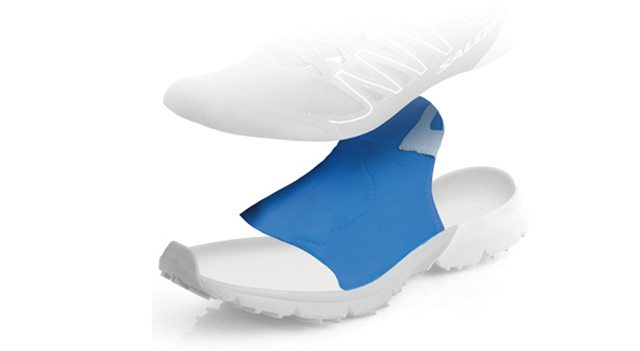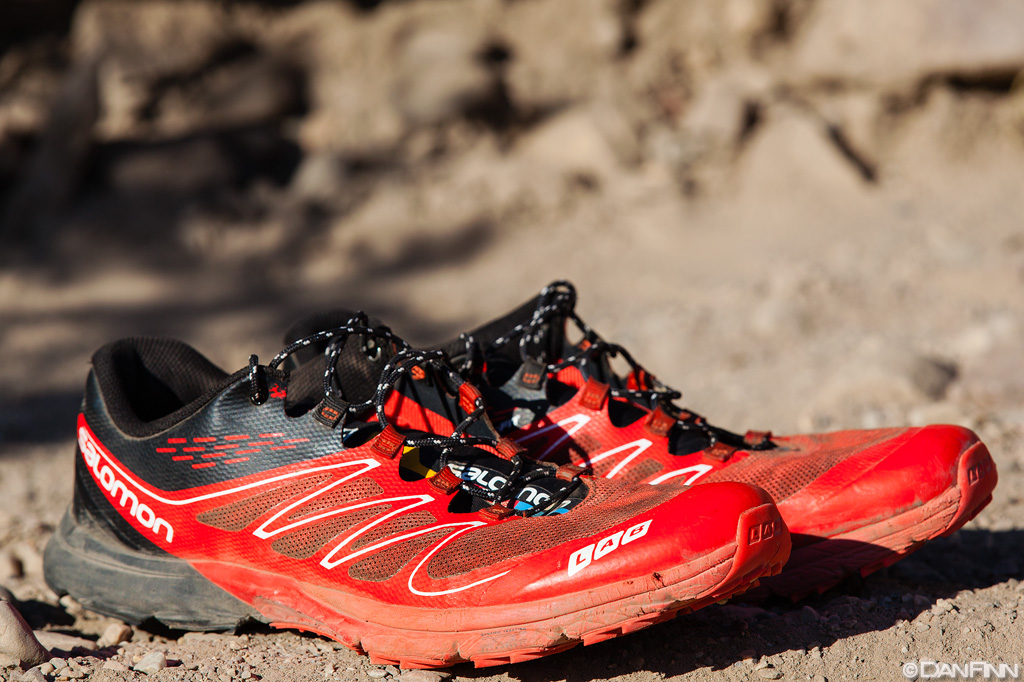Endofit Sleeve
Salomon calls the inside glove of the Sense Ultra the “Endofit”. The shoe is lined with a thin lycra-type material that feels great with or without socks; it is very comfortable to the skin.

The lycra does, however, hold a bit of water from stream crossings or sweat, so the external mesh will not completely dry. It can and will wet-out and hold dirt, and after six weeks of use, the mesh is basically black from dirt discoloration on the formerly red mesh. It’s no big deal, and I haven’t even bothered to wash the dirt off to see how well it cleans up.
But this is the one area where the Sense Ultra is maybe a half star below the Pure Grit or MT110: its ability to drain when you run through a stream crossing or puddle. The Pure Grit seems to drain in one or 2 steps, while the Sense Ultra takes maybe 1/8th of a mile to feel dry. Still, I think the Sense Ultra does very well here—as well as or better than the Merrell Trail Glove—it’s just a small notch below the best of the bunch in my experience.
Last Thoughts on the Quicklace System
I personally did not care for the Quicklace design for a few reasons. First, I felt that I had to pull the laces much tighter than normal to keep everything held down. I chalk that up to the laces being quite slick, so they slide in the eyelets very easily. When the laces are not pulled wicked tight, there was a bit of foot slippage in the shoe laterally. When I pulled the laces tight enough to prevent foot slippage, one of my feet regularly fell asleep. This issue was resolved immediately when I swapped to normal shoelaces.
(For what it’s worth, the Hoka One One shoes have a similar quicklace system, and Blister reviewer Lance Petersen has reported similar issues with those shoes. He has swapped the laces out for “normal” ones, and has also had positive results.)
I also have that very pronounced saddle bump on the top of my instep, so I found it difficult to squeeze my foot into the shoes because the quicklaces prevent the tongue from opening the way a shoe can normally open when untied and unencumbered.
99% of people out there will have absolutely no problem sliding their foot into the shoe with the Quicklaces, but going to normal laces immediately resolved this issue, should you happen to have any difficulty.
S-LAB SENSE ULTRA: The Price
At $180, there is no way of getting around the fact that the Salomon S-Lab Sense Ultra is pricey. Salomon also makes the Sense Mantra (priced at $120), which is a little heavier, a little more rigid, slightly less responsive version of the shoe. But I am not fully convinced that the Mantra would last any longer than the Ultra, however, since the outsole and midsole are made of the same materials.
With the Ultra, the price tag is aligned to the performance you gain—the shoes simply fly. This is the difference between very good gear and top-level race gear, and that is why the Ultra is priced the way it is.

Final Comparisons: Salomon S-Lab Sense Ultra vs. Brooks Pure Grit vs. New Balance MT110
Relative to other shoes on the market, I would put the S-Lab Sense Ultra at or near the summit of every criteria I use to evaluate shoes. They are super light. They provide adequate rock protection. They are very responsive. They fit well and are very comfortable. And they have proven to be durable.
There is not one category where the S-Lab Sense Ultra is head-and-shoulders better than everything else on the planet, but they consistently perform near the benchmarks of each category, with seemingly no big weaknesses or compromises. I cannot think of a usage in which I would prefer my two previous favorite shoes over the Sense Ultra, unless I am specifically interested in reducing the amount of feedback the shoe gives for a very particular trail.
On the other hand, I can list several issues that the Pure Grit and MT110 have (the Pure Grit’s upper is too stretchy and the sole is a bit dead and sluggish, while the MT110 can be a bit harsh on the forefoot, and downright painful on the midfoot.) The Ultra shoes, as far as I can tell, really do not have a weakness.
Bottom Line (& Who’s It For?)
The Salomon S-Lab Sense Ultra is a well-executed shoe that is fast and responsive, has a nice blend of cushioning and trail feel, and protects from rock strikes.
Those who have been running in barefoot shoes or road racing flats will not have any problem hopping right into the S-Lab Sense Ultra and flying.
Those coming from more built up and cushioned, higher drop, trail running shoes will almost certainly need a good bit of time to get used to the S-Lab Sense Ultra, since the amount of trail feedback, the highly flexible nature of the shoe, and the low drop will all be quite a change from what they are used to.

Is there anyone out there who actually likes speed laces?
They seem to be the answer to a question that only triathletes ever asked.
Most long-distance runners will attest that their feet expand after running considerable miles. A lacing that felt supportive before the race started will often feel to tight at mile 30, at least for me. Making a minor adjustment to the lacing tightness by using speed-laces is much quicker than untying my whole shoe and retying it from scratch. This is the reason why many ultra runners even fit speed-laces to their non-Salomon shoes.
thanks for the comment!
i totally agree its a very personal thing on those laces. i have had no issue needing to re-lace/re-tie at the 50k distance, but I’m not super ultra beyond that.
my gripe with speed laces is more a fit issue. i have a very wide forefoot and a very low volume instep and heel, so i run with almost no lace pressure across the toes and max tightness on the upper 2 lace holes. with “speed-setups”, where the lace is very thin and smooth, the shoe naturally pulls even tension across the whole foot, and that leads to fore-foot cramping and a lifting heel for me. i like a little friction in the laces at the lace-holes so that i can run the laces with the appropriate tension at different places on my foot.
all the best
Were this tested with the stock insoles (which roughly resemble wet paper) or something else? I almost always slip Superfeet or similar in my trail runners, BUT obviously didn’t in something a NB Minimus. These seem to be a little in between. I’ve done one run in my Sense 2s with green Superfeet from another shoe and they were fine, but certainly had an impact on the fit. Obviously, it’s personal preference, but was just curious what others were doing.
I noticed my achilles agitated after my initial run in these shoes. I’ve run in 4mm drop shoes so I didn’t exactly think that would be the reason. I also have a full volume foot also and was curious about what you said with the speed laces. Do you think for any reason that removing the speed laces may alleviate the achilles thing? It feels like my foot is locked in such a way that the tendon is forced and can’t flex like it should. If that’s not the issue I’d rather not do it and risk not being able to return them. Curious if may have any feedback as it seems that you had some initial issues, also.
Thanks!
hi michael, if you are over-tight on the forefoot, i could see that causing *some* problem by over compensating somewhere else in the foot/leg.
cutting the pull tab worked for me, for sure, but its a one-way process… hard to “recommend” per se, but i had great results when i did. if you do, i hope it works well!
sorry if that is not more helpful?
I just bought a pair of Solomon trail shoes and wanted to replace the quick laces with regular laces to prevent heel slippage, but the eyelet holes seem so small. When I called Solomon to ask if there were regular laces that would fit they said they didn’t know of any. What kind of laces did you use?